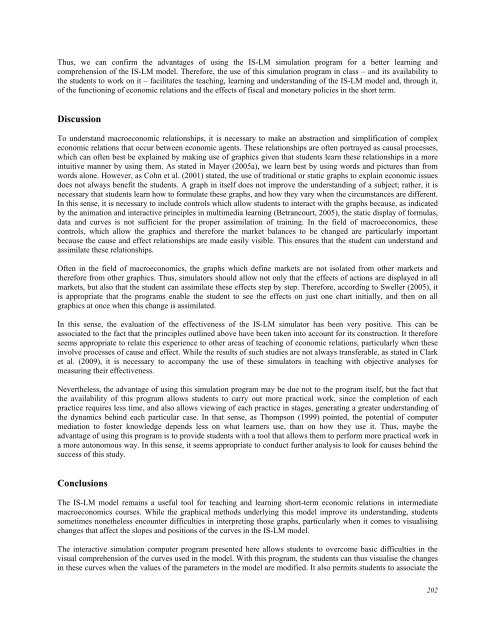October 2012 Volume 15 Number 4 - Educational Technology ...
October 2012 Volume 15 Number 4 - Educational Technology ...
October 2012 Volume 15 Number 4 - Educational Technology ...
Create successful ePaper yourself
Turn your PDF publications into a flip-book with our unique Google optimized e-Paper software.
Thus, we can confirm the advantages of using the IS-LM simulation program for a better learning and<br />
comprehension of the IS-LM model. Therefore, the use of this simulation program in class – and its availability to<br />
the students to work on it – facilitates the teaching, learning and understanding of the IS-LM model and, through it,<br />
of the functioning of economic relations and the effects of fiscal and monetary policies in the short term.<br />
Discussion<br />
To understand macroeconomic relationships, it is necessary to make an abstraction and simplification of complex<br />
economic relations that occur between economic agents. These relationships are often portrayed as causal processes,<br />
which can often best be explained by making use of graphics given that students learn these relationships in a more<br />
intuitive manner by using them. As stated in Mayer (2005a), we learn best by using words and pictures than from<br />
words alone. However, as Cohn et al. (2001) stated, the use of traditional or static graphs to explain economic issues<br />
does not always benefit the students. A graph in itself does not improve the understanding of a subject; rather, it is<br />
necessary that students learn how to formulate these graphs, and how they vary when the circumstances are different.<br />
In this sense, it is necessary to include controls which allow students to interact with the graphs because, as indicated<br />
by the animation and interactive principles in multimedia learning (Betrancourt, 2005), the static display of formulas,<br />
data and curves is not sufficient for the proper assimilation of training. In the field of macroeconomics, these<br />
controls, which allow the graphics and therefore the market balances to be changed are particularly important<br />
because the cause and effect relationships are made easily visible. This ensures that the student can understand and<br />
assimilate these relationships.<br />
Often in the field of macroeconomics, the graphs which define markets are not isolated from other markets and<br />
therefore from other graphics. Thus, simulators should allow not only that the effects of actions are displayed in all<br />
markets, but also that the student can assimilate these effects step by step. Therefore, according to Sweller (2005), it<br />
is appropriate that the programs enable the student to see the effects on just one chart initially, and then on all<br />
graphics at once when this change is assimilated.<br />
In this sense, the evaluation of the effectiveness of the IS-LM simulator has been very positive. This can be<br />
associated to the fact that the principles outlined above have been taken into account for its construction. It therefore<br />
seems appropriate to relate this experience to other areas of teaching of economic relations, particularly when these<br />
involve processes of cause and effect. While the results of such studies are not always transferable, as stated in Clark<br />
et al. (2009), it is necessary to accompany the use of these simulators in teaching with objective analyses for<br />
measuring their effectiveness.<br />
Nevertheless, the advantage of using this simulation program may be due not to the program itself, but the fact that<br />
the availability of this program allows students to carry out more practical work, since the completion of each<br />
practice requires less time, and also allows viewing of each practice in stages, generating a greater understanding of<br />
the dynamics behind each particular case. In that sense, as Thompson (1999) pointed, the potential of computer<br />
mediation to foster knowledge depends less on what learners use, than on how they use it. Thus, maybe the<br />
advantage of using this program is to provide students with a tool that allows them to perform more practical work in<br />
a more autonomous way. In this sense, it seems appropriate to conduct further analysis to look for causes behind the<br />
success of this study.<br />
Conclusions<br />
The IS-LM model remains a useful tool for teaching and learning short-term economic relations in intermediate<br />
macroeconomics courses. While the graphical methods underlying this model improve its understanding, students<br />
sometimes nonetheless encounter difficulties in interpreting those graphs, particularly when it comes to visualising<br />
changes that affect the slopes and positions of the curves in the IS-LM model.<br />
The interactive simulation computer program presented here allows students to overcome basic difficulties in the<br />
visual comprehension of the curves used in the model. With this program, the students can thus visualise the changes<br />
in these curves when the values of the parameters in the model are modified. It also permits students to associate the<br />
202

















